E. Kristin Anderson's Blog, page 34
July 26, 2013
Review: PARADOX by A.J. Paquette
Leave it to A.J. Paquette to take the dystopian novel and turn it on its head. In PARADOX, Ana has recently woken on a strange, barren planet, with little other than her name (which she only remembers because of a tag pinned to her suit). Her mission? To survive.
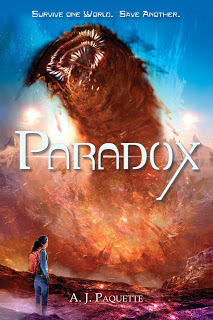
Random House Books for Young Readers, June 2013.
Ana’s memories are gone, and as she begins her trek toward she’s not sure what, she’s sure she’s alone. But it’s not long before she realizes she’s, in fact, not the only living creature here. There’s a giant, worm-like creature, seemingly in pursuit of her, and as her fear heightens, so does her determination to make it out alive. But the worm isn’t the only other life here. There’s a boy, dressed in the same suit as her, presumably from the same ship as her, who says he knows the way to the colony, where there are other people and supplies. Ana knows they should team up, but she has reservations. When there are no memories to guide you, who can you trust? And what is real?
PARADOX is a gripping novel of survival against the odds, and of the persistance of the human spirit. This is a book that will keep you reading until the middle of the night, straining to keep your eyes open, hoping you can get in just one more chapter. A new twist on dystopia? A.J. Paquette totally nailed it.





July 24, 2013
Guest Post from Debbie Levy: The Footnotes
IMPERFECT SPIRAL is about the aftermath of a tragic accident, in which Humphrey Danker, the five-year-old boy Danielle Snyder is babysitting, runs into traffic to chase down his football. It’s also, and equally, about the summer Danielle and Humphrey spent together and the deep connection they forged.
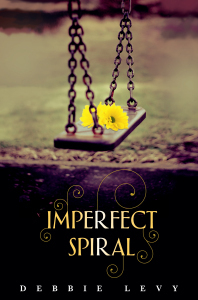
Walker Children’s, July 2013.
To me, and I hope to readers, my characters are very real. But of course, they’re not really real. IMPERFECT SPIRAL is fiction. And yet—one of the pleasures of writing fiction is that while you’re creating people and events mostly out of thin air, you can add texture and depth to it all by finding a home for stuff you’ve been carrying around inside. For personal stuff.
None of the personal stuff is labeled as such. But what if it were. . . . (Cue swirly music evoking a dreamy, “what-if” state.)
When Mrs. Danker came home from radiation, she didn’t usually eat. It wasn’t that radiation made you sick, Mrs. Danker had told me. It wasn’t like chemotherapy. It just made her feel a little whipped. After she rested for an hour or so, she usually ate something small and cold. A yogurt. A little container of cottage cheese. She liked cold red plums. 1
Footnote 1, page 46 of IMPERFECT SPIRAL - This is how I felt while undergoing radiation treatments for breast cancer when I was thirty-nine. Especially about the cold red plums. It wasn’t the worst thing ever, not by a long shot. But it was reality-changing. And I still love cold red plums.
I pushed my way through two overflowing displays. A third one quivered. Wait. Unless that rack was alive, it had no business quivering. Unless. I found Humphrey nestled between two velvet leisure suits. He was holding the purple fabric of the jacket between the index and middle fingers of his right hand, and holding— no, clutching— one of the purple pant legs in his left hand.
“Humphrey!” I exclaimed.
He was absolutely in rapture. “These give me tears,” he said. 2
Footnote 2, page 49 – Oh, be still, my heart. This scene reflects the time in Nordstrom when one of my sons disappeared for a few minutes deep in a rack of truly hideous “Activewear” suits. We were shopping for a gift for Grandma. They were plenty ugly, but Ben wasn’t even looking at them; he was stroking the soft, petal-like fabric, the way he used to stroke the satin edge of his blanket. “These give me tears,” he said, he really did.
(Don’t worry, my other son, Alex, has his own footnote later in that same chapter, which also makes my heart go pitter-patter. Equal treatment of the offspring.)
After the Torah reading, it was time for my speech, which I’d also been working on for nearly a year. I was proud of the insights I’d come up with about my Torah portion, which is the part in the Bible where Jacob knows he’s dying and he gives this kind of awkward blessing to his son Joseph’s two sons. But the wave was way too strong for me, and it swept me off the stage and down the short hallway that connects to the rabbi’s study, where I tumbled into a chair and hyperventilated. 3/
Footnote 3, page 73 – This mirrors what happened at my Bat Mitzvah, when, like Danielle in this flashback, I was swept off the podium by a wave of panic and ended up running to the rabbi’s study. Mortifying. Talk about reality-changing.
But reality has a way of changing, which is good. I finally become comfortable speaking in front of people when I took a summer job during college as a tour guide in Washington, D.C., responsible for keeping a busload of eighty-eight hot and sweaty tourists entertained and informed. A microphone can be empowering! It was the best job ever, partly because of all I learned about my hometown, partly because the guides and drivers were mostly other fun college students, and partly because I always knew what I was going to wear to work—day in and day out, one of the two orange-and-white wash-n-wear dresses they gave to us girl guides. I never realized how liberating a uniform could be.
(Cue swirly music bringing us back to the here-and-now.)
Would the creation of annotated editions of novels take away the magic of fiction? Maybe. But I think that, as readers, we can’t help but wonder what came from experience and what from imagination. And as writers, we try to balance privacy considerations, the impulse to spill everything out on the page, and the imperative of keeping things compelling—because, after all, most things that are real aren’t all that compelling.
Finally, this assumption that fiction must reflect, at least in part, the author’s own experience is one of the things that makes novel-writing feel dangerous. Readers might assume that a particular distressing event or dislikeable character trait comes from the author’s life, when actually it’s pure invention. Wow, the reader might think, that must come from a dark and weird personal history when really it has nothing to do with the author personally. But you may never look at the author in the same way again.
Oh, well. It’s an occupational hazard, and mostly, we don’t tell. But if you gather people in a virtual room like this blog to blab about your book, I kind of think you ought to divulge at least a few of the hidden footnotes. And so I have. As for the others—I’ll leave them hidden. Except for this: pretty much all of Humphrey’s excellent traits reflect the adorableness and interesting-ness that characterized my two boys when they were his age.
It’s true! I know I am the only mother to think this about her children.

Debbie Levy.
Debbie Levy writes books — fiction, nonfiction, and poetry — for people of all different ages, and especially for young people. Before starting her writing career, she was a newspaper editor; before that, she was a lawyer with a Washington, D.C. law firm. She has a bachelor’s degree in government and foreign affairs from the University of Virginia, and a law degree and master’s degree in world politics from the University of Michigan. She lives in Maryland and spends as much time as she can kayaking and otherwise messing around in the Chesapeake Bay region.





July 15, 2013
Show Me Your Notebook! A glimpse into the (paper) brains of real, live authors.
I’m always talking about the value of paper notebooks as writers. Not everyone uses them, but a lot of us do. And most of us use them in different ways. A few weeks ago I shared my notebooks with you, but I thought it would be interesting to see how other authors put pen to paper. I asked around to see if I could get a few authors to share a page or two and here’s what I found:
From Bryony Pearce, author of ANGEL’S FURY and THE WEIGHT OF SOULS:
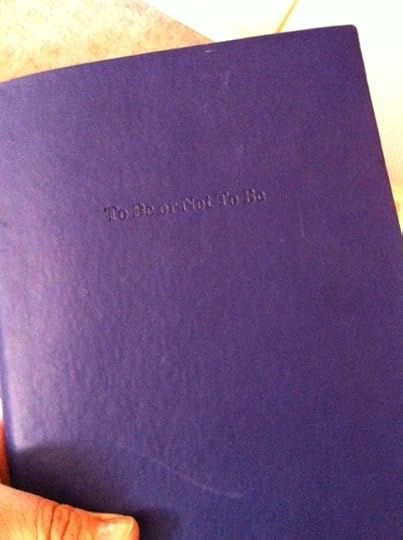
One of Bryony Pearce’s notebooks.
I often don’t feel like a real writer. I never have a pen, I’m always struggling to find paper, or a notebook. I imagine that a ‘real writer’ would have a special silver ‘book signing pen’ with them at all times and that in their back pocket they would have a leather bound notebook which would contain, in a very neat hand, all of their incisive observations about life.
In fact I do have a number of gorgeous leather bound notebooks (here is one).
But here is my confession. I find them all too nice to write in.
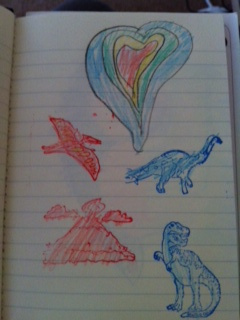
Illustrations from Bryony’s kids.
I haven’t yet come up with a single sentence that I feel is ‘good enough’ to go in my gorgeous leather bound books. The simple loveliness of these empty pages is just too intimidating. I cannot use them for my everyday ramblings – thoughts on books, observations, lists for camping and Sainsburys, things to do lists (of which I have a great number), ideas for birthday presents and so on.
So my gorgeous leather notebooks honestly, remain untouched.
I have a ‘lower grade’ of notebook, which I consider ‘writable in’. However, my daughter and son keep finding these books and they are filled with things like this; they have also become unusable, if not equally precious.
So what I really use to write in are very small paper bound notebooks. I get them from TK Maxx. They fit in my pocket or handbag and they are scrappy enough for my scrappy thoughts; appropriate notebooks for a busy mum who is self-conscious about her ramblings, unwilling to make more out of them than is necessary, not wanting to dress them up in leather.
In the page below I have been trying to work out the genetics behind Taylor’s curse.
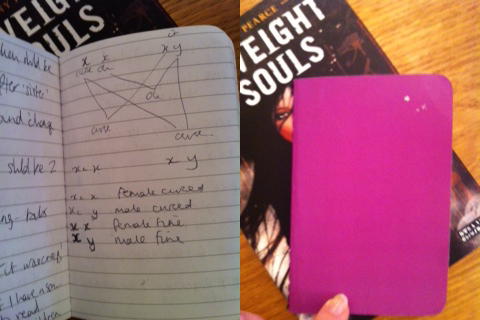
Bryony’s WEIGHT OF SOULS notebook.
From Maureen McGowan, author of DEVIANTS and COMPLIANCE:
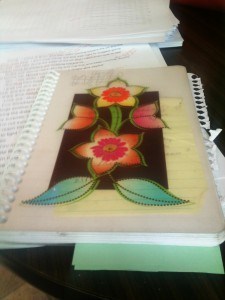
The cover of one of Maureen McGowan’s recent notebooks.
My office is full of notebooks. Notebooks with story ideas. Notebooks with handwritten scenes. Notebooks with scribbled notes from writers’ workshops or critique group feedback. Here is a photo of my current notebooks, with real pressed flowers on (in?) the cover.
I wish I could say I was organized and able to immediately put my fingers on any of these notebooks when desired, but alas, I cannot.
When I’m working on a book, I often scribble notes and ideas in a notebook. I draw maps of scenes, trace through plot lines or sketch out character arcs, if I’m confused about motivations.
And sometimes just putting pen to paper, versus fingers to keyboard, helps get the creative juices flowing. Even if the juice is often messy.
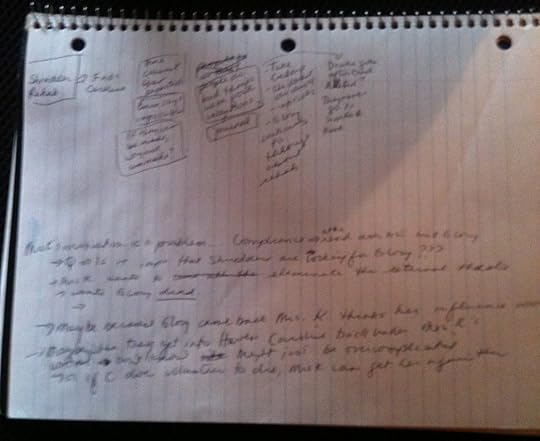
Some of Maureen’s notes.
From Margo Sorensen, author of ISLAND DANGER and TIME OF HONOR:
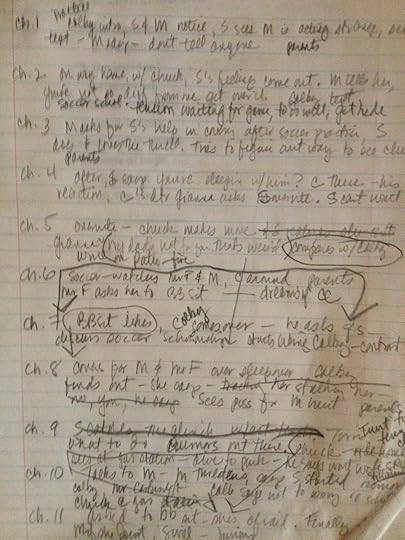
Margo Sorensen’s outline. (Click to enlarge.)
This draft of my latest YA chapter outline (PLAYING WITH FIRE) is from my author’s notebook, and I do this only after I’ve sketched out the characters, asked plenty of “what if?” questions, and filled out an awesome “fiction outline” courtesy of YA author Mary Casanova. Notice that I never erase anything, but just cross out the words; someone suggested that years ago, just in case I want to use those “golden words” (not!) again. When I put it on the computer, I keep an “outtakes” file for those “digital cross-outs.” In the beginning stages, there’s something about the synergy of pencil and paper in my author’s notebook that keeps the creativity going!
From Colleen Conrad:
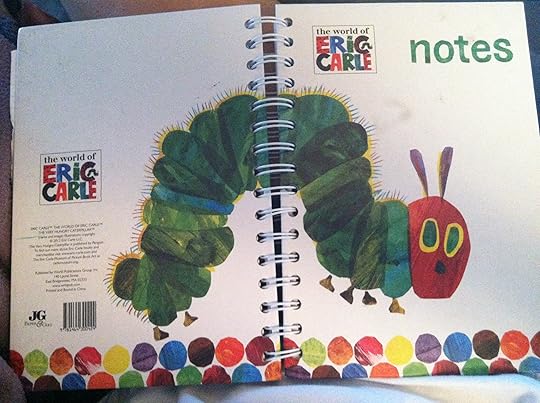
The cover of Colleen’s most recent journal.
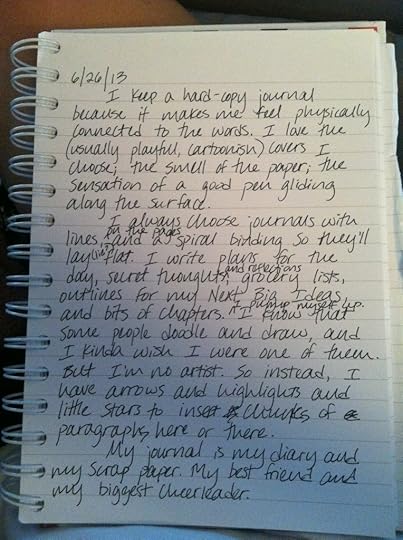
Colleen Conrad chose to share a page where she actually reflects on why and how she uses her journal.
From Elissa Janine Hoole, author of KISS THE MORNING STAR and SOMETIMES NEVER, SOMETIMES ALWAYS:
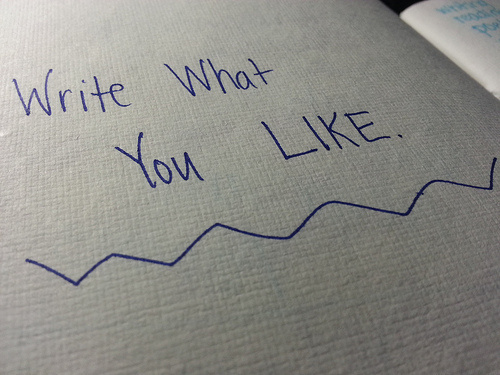
A page from Elissa Janine Hoole’s journal.
This picture is from my favorite journal, my favorite part of it. It says Write What You Like, obviously, and then it’s followed by a list of things I’m interested in, things I like, things I find fascinating. I keep adding to it so it grows and grows, and it inspires the kinds of stories and themes I end up writing about in my books!
From Lesléa Newman, author of OCTOBER MOURNING: A SONG FOR MATTHEW SHEPARD:
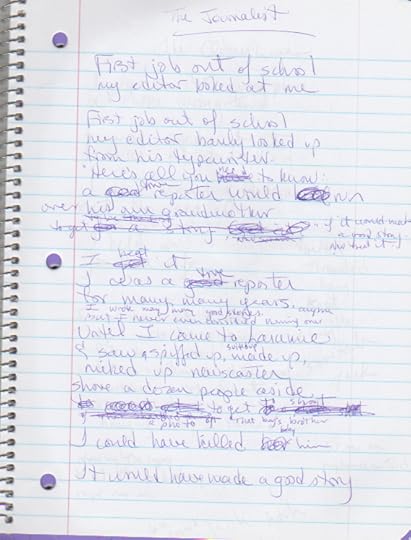
From Lesléa’s notebook.
I have written with a BIC pen and spiral notebook ever since I was in high school. The feeling of a pen in my hand is different than the feeling of my hands on a keyboard. Staring at a blank piece of paper with all those empty lines, blue as horizons, stirs something in me that cannot be duplicated by staring at a computer screen. Everything I have ever written has been born in a notebook.
This is a handwritten draft of “The Journalist” from OCTOBER MOURNING: A SONG FOR MATTHEW SHEPARD.
Fellow writers: What do YOUR notebooks look like? I’d love to see some pics in the comments!





July 12, 2013
Review: THE THEORY OF EVERYTHING by Kari Luna
Sometimes you read a book and the whole time you’re reading that book you feel like you’re locking elbows with the main character and skipping around the neighborhood with them. No? That’s just me? That’s okay. I’m a little different. And so is Sophie Sofia, the main character in Kari Luna‘s spectacular debut novel, THE THEORY OF EVERYTHING.
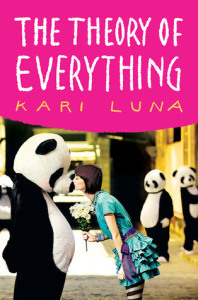
Philomel, July 2013.
Sophie Sofia is the daughter of a brilliant physicist who has disappeared so often that when it becomes a sort of forever thing — as in Sophie’s mom has moved them first to San Francisco and now to suburban Illinois — Sophie has to accept that maybe her dad might not be the good guy she always thought he was. She remembers amazing times with him. Building things. Going to the zoo instead of school. Playing games. But what kind of a dad would abandon his family?
Here’s the other thing about Sophie’s dad: he sees things. Has episodes. And when he disappears, he’s not participating in the reality that everyone else is. Now Sophie is starting to experience this, too, which has lead her and her mother to this new town which isn’t even close to Chicago (a real city!) and which still isn’t Brooklyn (home). The good news is, despite stage diving into the popular girls’ lunch table during a very Ramones episode, Sophie is making friends. And a guy might even like her. The bad news is, she’s starting to have recurring episodes. As in, a shaman Panda named Walt that only she can see. And Walt seems to think he can guide her down a path that will solve everything, with a little help from string theory and a lot of help from her new BFF Finny.
THE THEORY OF EVERYTHING is beautiful and exciting and hilarious. And it’s also sad. Like, have-some-tissues-ready sad. The heartbreaking beauty of Sophie’s story is profound and thrilling, and something that I think readers of Meg Rosoff and John Green will enjoy. Besides, who doesn’t want to read a story about a girl with a shaman panda? I can’t wait to read Kari Luna‘s next novel.





July 10, 2013
Sucker Literary Blog Tour! Guest Post from Josh Prokopy: On Setting
One of the great things about fiction set in another place or culture is that it gives you the chance to dive into that culture through the medium of story, to learn something about an unfamiliar place and gain a new perspective on the world.
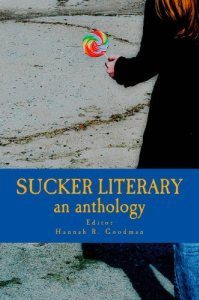
Sucker Literary, March 2013.
I spent two and a half years living in Thailand, a country in Southeast Asia, and that experience has informed much of my writing. My story for Sucker centered on an exchange student named Marcus. I had a blast writing that story and describing his host family’s cinderblock outhouse and cramped little shop, the battered pick-up truck that served as a school bus, and the thick red mud of the rainy season. It took me back to my own days in Thailand, and gave me the chance to bring a small slice of that world to life for my readers.
But bringing a strange and exotic setting to life takes work. You can’t just say that your main character sidled up the counter at a McDonald’s and expect everyone know what you mean. You’ve got to describe the tile floor, the uniforms, the pictures of Ronald McDonald, and the smell of greasy burgers. And you’ve got to do it with confidence and clarity. Because if you don’t believe what you’re describing, no one else will either.
That holds true whether the setting is a real place or one that comes straight out of your imagination, but when it’s real you have to take things a step further to ensure that the image you’re creating is not only believable, but accurate. So back to our example of the McDonald’s. Pretend for a moment you’ve never set foot inside a fast food restaurant before. All you have to go on are second hand reports and pictures off the internet. That might be enough to provide a good visual description, but for a setting to really pop you’ve got to weave in some of the other senses – the noise of the kitchen, the taste and aroma of the fries, or the feel of a hard plastic chair. And that kind of sensory detail can be hard to get off the internet. You have to take what little you can find and combine it with relevant experiences from your own life. Because even if you’ve never been inside a McDonald’s, you’ve probably heard the noise and clatter of a restaurant kitchen, smelled greasy food, or sat on something hard.
I ran into this problem with one of the books I’m working on. It’s an action novel set in the mountains of northern Thailand. My main character, Caleb, travels to a small tribal village where he eats in smoke filled huts, sleeps on a bamboo mat, and sloshes through rice paddies. I’ve done all that, and was able to draw on my own experience to make it ring true.
But Caleb also spends a good chunk of the story out in the woods, on the run from a tribal militia. These were intense scenes, full of action, fear, and desperation. But for some reason they came out feeling flat. Stepping back, I realized that the problem lay in my setting. Unlike the villages and rice paddies, I’d never spent any real time in the forests of northern Thailand. I couldn’t picture it clearly, and my descriptions were vague and lifeless.
I spent hours on the internet – looking at photos on Google, surfing YouTube for trekking videos, checking any number of sites for information on trees, plants, and wildlife. But the few YouTube videos I found weren’t particularly clear on where they’d been taken, and most of the information on plants and trees was in scientific studies filled with Latin names.
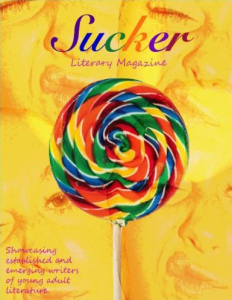
Sucker Literary, March 2012.
Still, I managed to piece together enough basic information to know that the forest would be dominated by deciduous trees with few branches or leaves low down on the trunk. There would be vines and woody creepers, and the vegetation on the forest floor would probably include ferns and rhododendrons. It wasn’t a complete picture by any means, but it gave me a reasonably concrete image to latch on to. And with that image I found the confidence to write the following description:
The vegetation grew in a thick tangle of ferns, rhododendrons, and leafy shrubs. Tall trees shot into the air, dripping with desiccated woody vines that crisscrossed the canopy like telephone wires before trailing back down to the ground. Unlike trees back home, their narrow trunks were nearly devoid of branches until, high up near the top, they suddenly mushroomed out in a cloud of long, heavy leaves.
One of the great things about fiction set in another place or culture is that it gives you the chance to dive into that culture through the medium of story, to learn something about an unfamiliar place and gain a new perspective on the world.
I spent two and a half years living in Thailand, a country in Southeast Asia, and that experience has informed much of my writing. My story for Sucker centered on an exchange student named Marcus. I had a blast writing that story and describing his host family’s cinderblock outhouse and cramped little shop, the battered pick-up truck that served as a school bus, and the thick red mud of the rainy season. It took me back to my own days in Thailand, and gave me the chance to bring a small slice of that world to life for my readers.
But bringing a strange and exotic setting to life takes work. You can’t just say that your main character sidled up the counter at a McDonald’s and expect everyone know what you mean. You’ve got to describe the tile floor, the uniforms, the pictures of Ronald McDonald, and the smell of greasy burgers. And you’ve got to do it with confidence and clarity. Because if you don’t believe what you’re describing, no one else will either.
That holds true whether the setting is a real place or one that comes straight out of your imagination, but when it’s real you have to take things a step further to ensure that the image you’re creating is not only believable, but accurate. So back to our example of the McDonald’s. Pretend for a moment you’ve never set foot inside a fast food restaurant before. All you have to go on are second hand reports and pictures off the internet. That might be enough to provide a good visual description, but for a setting to really pop you’ve got to weave in some of the other senses – the noise of the kitchen, the taste and aroma of the fries, or the feel of a hard plastic chair. And that kind of sensory detail can be hard to get off the internet. You have to take what little you can find and combine it with relevant experiences from your own life. Because even if you’ve never been inside a McDonald’s, you’ve probably heard the noise and clatter of a restaurant kitchen, smelled greasy food, or sat on something hard.
I ran into this problem with one of the books I’m working on. It’s an action novel set in the mountains of northern Thailand. My main character, Caleb, travels to a small tribal village where he eats in smoke filled huts, sleeps on a bamboo mat, and sloshes through rice paddies. I’ve done all that, and was able to draw on my own experience to make it ring true.
But Caleb also spends a good chunk of the story out in the woods, on the run from a tribal militia. These were intense scenes, full of action, fear, and desperation. But for some reason they came out feeling flat. Stepping back, I realized that the problem lay in my setting. Unlike the villages and rice paddies, I’d never spent any real time in the forests of northern Thailand. I couldn’t picture it clearly, and my descriptions were vague and lifeless.
I spent hours on the internet – looking at photos on Google, surfing YouTube for trekking videos, checking any number of sites for information on trees, plants, and wildlife. But the few YouTube videos I found weren’t particularly clear on where they’d been taken, and most of the information on plants and trees was in scientific studies filled with Latin names.
Still, I managed to piece together enough basic information to know that the forest would be dominated by deciduous trees with few branches or leaves low down on the trunk. There would be vines and woody creepers, and the vegetation on the forest floor would probably include ferns and rhododendrons. It wasn’t a complete picture by any means, but it gave me a reasonably concrete image to latch on to. And with that image I found the confidence to write the following description:
The vegetation grew in a thick tangle of ferns, rhododendrons, and leafy shrubs. Tall trees shot into the air, dripping with desiccated woody vines that crisscrossed the canopy like telephone wires before trailing back down to the ground. Unlike trees back home, their narrow trunks were nearly devoid of branches until, high up near the top, they suddenly mushroomed out in a cloud of long, heavy leaves.
That’s a crisp visual description, but it wasn’t enough. To make my forest really jump off the page, I had to weave in additional layers of description drawing on some of the other senses. First off was sound. I found a website that played recordings of some of the noises you might hear in a Thai forest, and used it to write descriptions like the following:
Around me the forest was just waking up, and the chirp of crickets had given way to the overlapping trill and warble of a hundred different kinds of birds. Who-wup, who-wup, tup, tup tup, kack. The myriad sounds wrapped around one another, mixing with the crunch of feet on the wet leaves and the echoing cough of a distant deer.
To round out the image I wove in a layer of touch. Since touch isn’t something you can learn about online, I had to look for sensory details I was familiar with – details that would be as true for the forests of northern Thailand as for the Midwestern forests where I go hiking. What I settled on was rain:
Above us, the sky opened up and rain spattered down through the trees. I felt the cool drops on my skin as they dripped from the canopy and puddled on the leaf strewn ground… Then the rain slowed to a soft patter, and from all around came the steady drip drop of water. Beneath the leaves, the rich red dirt had turned to mud, and as my shoulder brushed against the long spiky fronds of a banana tree, a small torrent of trapped water cascaded onto my head.
Visual images, sound, touch, smell, taste – each of them plays an important role in bringing your setting to life. Whether that setting is real or comes straight out of your imagination you’ve got see it and feel it before you can describe it to your readers. That sometimes takes research, but it also requires a willingness to look into your own life, to draw on your own experiences in order to build a rich and believable world for your readers.
Josh Prokopy is a stay-at-home dad and former social worker who’s still fairly new to the writing biz. One of his stories, “The Dream Guide,” appeared in the March/April 2012 issue of Cicada, and another, “Burmese Tears,” won the 2011 Luminis Prize. He runs a website for reviewing YA and Middle Grade action/adventure novels (www.yaactionadventurenovels.com) and is working on two books in that same genre. He lives in Indiana and, when not writing, likes to spend his time reading, watching movies, hanging out with his family, and studying tae-kwon-do.
Josh Prokopy is also the author of “The Exchange Student” in Sucker Literary, Issue #1 –Marcus is fresh off the plane and feels lost and out of place. Everything about life in Thailand is different. He lives in a remote village where he’s forced to go to the bathroom on a squat toilet, eat rice gruel with chilies for breakfast, and travel to school in the back of an old pick-up truck. He can’t understand what anyone is saying, and he’s ready to pass out from the heat. All he wants to do is go home. Then he meets Dao. Her ready friendship calms his swirling heart and enables him to discover that, for all the strange new experiences Thailand has to offer, life there is not nearly so different as he’d first believed.





July 8, 2013
Double Cover Reveal: ALL IS FAIR by Emma Newman and PRINCE THIEF by David Tallerman
Two exciting books forthcoming from Angry Robot now have covers! These guys put out some fantastic speculative fiction, and I’m psyched for the covers, featured below:
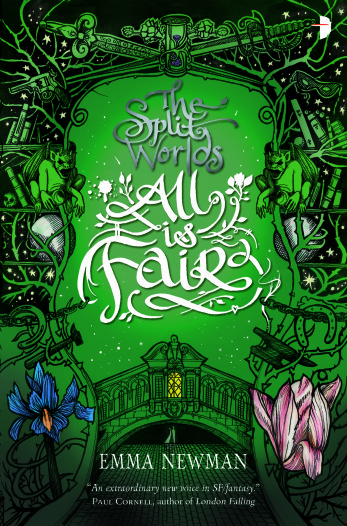
Angry Robot, September 2013.
(Cover by Sarah J. Coleman)
William Iris struggles to keep the throne of Londinium whilst hated by his own court and beset by outsiders, while Cathy discovers the legacy of her former governess. But those who dare to speak out about Society are always silenced. Sometimes for good.
While trying to avoid further torments from the mercurial fae, Sam finds himself getting tangled in the affairs of the Elemental Court. But an unexpected offer from the powerful and enigmatic Lord Iron turns out to be far more than Sam bargained for.
Max and the gargoyle are getting closer to uncovering who is behind the murder of the Bath Chapter and the corruption in London and Max finds the gargoyle’s controversial ideas harder to ignore. Can he stay true to his sworn duty without being destroyed by his own master, whose insanity threatens to unravel them all?
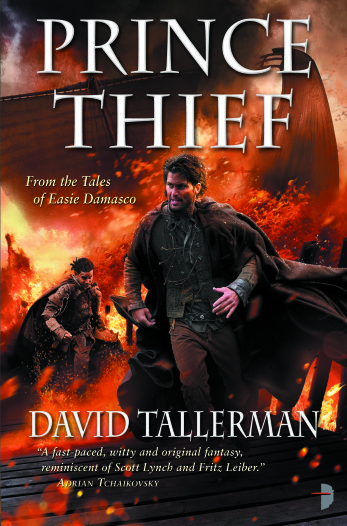
Angry Robot, September 2013.
PRINCE THIEF by David Tallerman
(Cover by Angelo Rinaldi, Artist Partners)
Altapasaeda, capital of the Castoval, is about to be besieged by its own king – and where else would luckless, somewhat reformed thief Easie Damasco be but trapped within the city’s walls? Faced with a war they can’t win and a populace too busy fighting amongst itself to even try, the Castovalian defenders are left with one desperate option. Far in the northern lands of Shoan, rebels have set up the young prince Malekrin as a figurehead in their own quest to throw off the king’s tyrannical rule. One way or another, the prince must be persuaded to join forces.
Once again, all hope lies with Damasco and his sticky-fingered approach to problem solving, along with his long suffering partner, the gentle giant Saltlick. But this time it’s a human being that needs stealing, with his own desires and opinions, and events only grow more complicated as Damasco realises that he and the rebellious young prince have more in common that either would admit.





July 5, 2013
Cover Reveal: WARD AGAINST DARKNESS by Melanie Card
Today Melanie Card and Entangled Teen are revealing the cover for book 2 in The Chronicles of a Reluctant Necromancer Series, WARD AGAINST DARKNESS. Also enter below for a paperback of the book or an eBook!
On to the reveal!
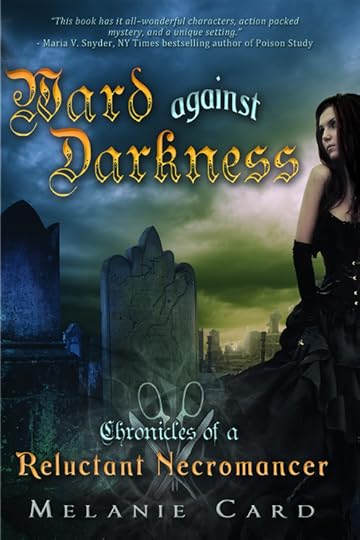
Entangled Teen, July 2013.
The last thing Ward de’Ath wants is more trouble. On the run from both the law and the criminal underworld, Ward and Celia flee Brawenal City only to stumble into the mansion of a powerful evil necromancer. And when Ward discovers the man possesses a dangerous grimoire, his duty leaves him no choice. He can’t allow the necromancer to keep the grimoire. But the mansion is filled with monsters–human and undead–and Ward has no way of telling who’s friend or foe. The only person he can trust is Celia who dominates more of his thoughts and feelings everyday. But there are still laws in the way of anything but friendship. She’s still dead and he’s still alive . . . for now.
Goodreads/Amazon/Barnes & Noble/The Book Depository
About Melanie:
[image error]
Melanie Card.
Melanie has always been drawn to story telling. In fact, she can’t remember a time when she wasn’t telling a story in her head or on paper. In grade school, they had journal writing time which she turned into story telling time, weaving tales of magic and adventure that mimicked the fairy tales and myths that she loved to read. It was there, with the help of two very special teachers, that she nurtured this love and started her journey as a writer.
She writes fantasy, paranormal romance, and everything in between, seasoned with a good dash of adventure and mystery. Join her on my tales of magic, adventure, and romance.
Website/Twitter/Facebook/Goodreads
Enter the Rafflecopter giveaway!





July 1, 2013
Please Pants Responsibly: Paper Notebooks For the Win
There are two ways to write a novel. Plotting (you make an outline, a plan, a roadmap if you will, and then you sit down and write it) and pantsing (you write “by the seat of your pants, throwing caution to the wind). So when I get asked if I’m a plotter of a pantser, I’m all like er, uh, hold on, let me? Pantser? I think? But I kind of, um, do planny things?
And it gets kind of awkward because in these inarticulate moments I have managed to confuse everyone including myself. And probably spilled a drink.
In recent discussions, however, I’ve had a bit of a revelation, silly as it is. I’ve realized that I — like many writers — am a plotter/pantser hybrid. And perhaps what I’m doing is something we could call Pantsing Responsibly. And, maybe, just maybe, I could share some of my responsible pantsing tips with other writers. Starting with paper notebooks.
Anyone can find a notebook. If there isn’t already one in your house (for shame!), you can get a notebook for like ninety-nine (American) cents at your grocery store. Or you can splurge and get a fancy Moleskine or something (I do, sometimes). Notebooks are as cheap as you need them to be, easy to come by, and presumably easy to use. But I guess with a lot of people doing the bulk of their writing on computers, using a paper notebook doesn’t come as naturally. So here are some plotter-esque things that any pantser can do with a notebook in hand.
[image error]
Some of my novelling notebooks: 1.AUGUST TIDES, aka NaNoWriMo 2010; 2. April of this year’s Camp NaNo, ANDI & VINE, cowritten with Priya Chand; 3. 1999; 4. GRUNGE, which I may never finish; 5. ME AND THE JERSEY DEVIL; 6. My first novel, MYSELF BEHIND MYSELF, back then just called “Jody Book;” 7. FOOL’s GOLD, which is no longer a novella (NaNoWriMo 2011); 8. COME ON EILEEN, aka Camp NaNo August 2012, cowritten with Priya Chand; 9. my current project, CHARLOTTE, AFTER.
1. Set aside a notebook for your project. Right now.
This might seem silly and self-indulgent, but the point is to organize all your thoughts and ideas for the project in one space. Now that I say it, it seems kind of obvious, right? I have a different notebook for every novel I’ve finished (and even some that I haven’t). And when I get feedback on drafts, and do revisions, I can go and keep all of that information in the notebook, too.
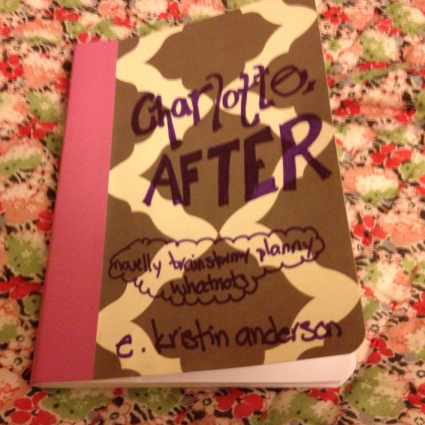
The cover of my CHARLOTTE, AFTER notebook. I like to prettify my notebooks.
2. Write a mini-synopsis.
Maybe you can’t write the whole thing. But if you can at least come up with a tag line (like what would be on the cover of a book or in a movie trailer), or a bit of a blurb (like the back of a book) it will be super helpful to you as you write!
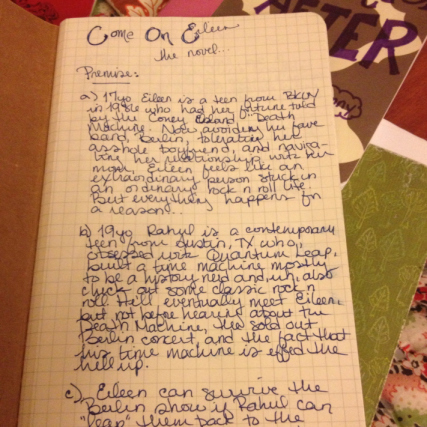
The synopsis page from COME ON EILEEN. Lots of these things changed as we wrote, but it was a good place to start.
3. Make a page for each of your main characters.
These are not character sheets. Okay, maybe a bit about how they look, bust mostly about how they think, their points of view, how they might act and talk. If there are important things you’re likely to forget (I forget stuff about cars all the time), write those down. I always note what kind of car my character drives (if they drive) and usually some hobbies.
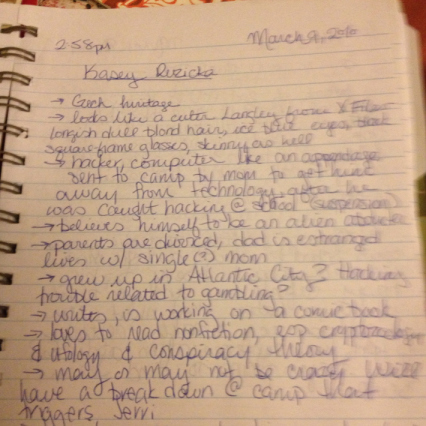
This is the character page for Kasey aka Ethan (name changes happen a lot) in my ME AND THE JERSEY DEVIL notebook.
4. Brainstorm.
Everyone’s style is different, but when I’m starting a book I like to have a few ideas on things like theme and voice and character development. But I also like to think about roadblocks a lot. I always say that the three things you need to know are who your character is, what she wants, and what’s in her way. One of the things I brainstorm either right after I start or even before is a list of possible roadblocks. The things that get in your character’s way are what add tension and excitement to the story. So having a list there is super helpful!
[image error]
The “Possible Crises” brainstorm page from my current project, CHARLOTTE, AFTER, which is a road trip book. (I like bears.)
5. Journal.
Every day can’t be a sit down and know exactly what to do with your story from the second you open the file day. When I’m stuck, one thing I do is journal about my writing, about the book, where it’s going and what loose ends I have to tie up. If you let yourself kind of freewrite about the story, you might realize where it needs to go, what happens next, or even get an idea for something new to try.
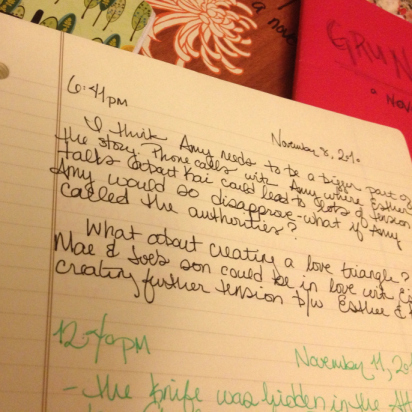
A page of journalling from AUGUST TIDES (working title VISITED THE SEA). There are many more pages of journaling like this, especially after I got revision notes from my agent. (This is the book that landed me said agent.)
Everyone’s notebooks will be different. From the kind of notebook you buy — I like smaller skinnier notebooks with pretty covers, you might like a legal pad — to what you do with it. But I don’t think any writer should be without one. I hope these tips are helpful for you pantsers out there looking for a way to organize. You don’t have to write a 50-page outline to prep for a new novel (though I know writers who work this way!), but life sure is easier as a novelist when you have some ideas to fall back on when you get stuck, and a bit of direction along the way.
Happy notebooking, y’all!









